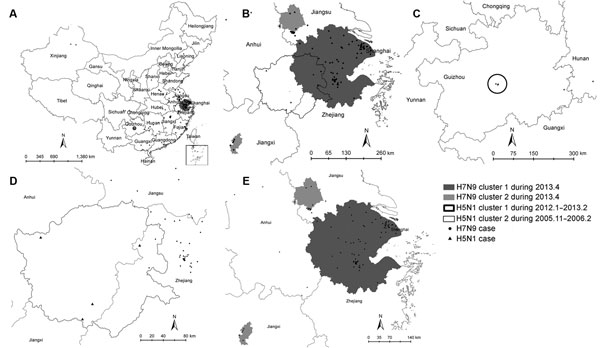Volume 19, Number 11—November 2013
Letter
Geographic Co-distribution of Influenza Virus Subtypes H7N9 and H5N1 in Humans, China
Figure

Figure. . . Geographic and temporal distribution of human cases of infection with avian influenza subtypes H7N9 (circles) and H5N1 (triangles), China. A) Distribution and space-time clusters of human influenza (H7N9) and influenza (H5N1) cases, calculated by using Kulldorff’s scan statistics in SaTScan version 9.1.1 (6). B) Spatial overlap between influenza (H7N9) and influenza (H5N1) case clusters in an area bordering the provinces of Anhui and Zhejiang. C) Primary cluster of influenza (H5N1) cases in Guizhou Province (relative risk [RR] 496.60). D) Secondary cluster of influenza (H5N1) cases in Anhui and Zhejiang Provinces (RR 65.27). E) Primary (RR 78.40) and secondary clusters of influenza (H7N9) cases on the boundary of Jiangsu and Anhui Provinces (RR 64.86) and in Jiangxi Province (RR 105.67).
References
- Gao R, Cao B, Hu Y, Feng Z, Wang D, Hu W, Human infection with a novel avian-origin influenza A (H7N9) virus. N Engl J Med. 2013;368:1888–97 . DOIPubMedGoogle Scholar
- Lam WY, Yeung AC, Ngai KL, Li MS, To KF, Tsui SK, Effect of avian influenza A H5N1 infection on the expression of microRNA-141 in human respiratory epithelial cells. BMC Microbiol. 2013;13:104 . DOIPubMedGoogle Scholar
- Zhang W, Wang L, Hu W, Ding F, Sun H, Li S, Epidemiological characteristics of cases for influenza A (H7N9) virus infections in China. Clin Infect Dis. 2013;57:619–20 . DOIPubMedGoogle Scholar
- Cowling BJ, Jin L, Lau EH, Liao Q, Wu P, Jiang H, Comparative epidemiology of human infections with avian influenza A H7N9 and H5N1 viruses in China: a population-based study of laboratory-confirmed cases. Lancet. 2013;382:129–37 . DOIPubMedGoogle Scholar
- World Health Organization. WHO case definitions for human infections with influenza A(H5N1) virus. 2006 [cited 2013 May 10]. http://www.who.int/influenza/resources/documents/
- Olsen SJ, Ungchusak K, Sovann L, Uyeki TM, Dowell SF, Cox NJ, Family clustering of avian influenza A (H5N1). Emerg Infect Dis. 2005;11:1799–801 . DOIPubMedGoogle Scholar
1These authors contributed equally to this article.